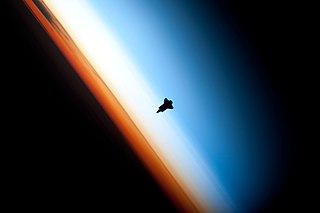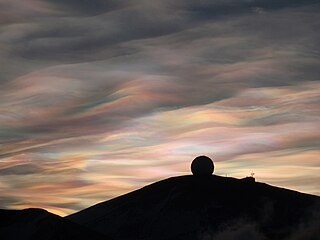
The stratosphere is the second layer of the atmosphere of the Earth, located above the troposphere and below the mesosphere. The stratosphere is an atmospheric layer composed of stratified temperature layers, with the warm layers of air high in the sky and the cool layers of air in the low sky, close to the planetary surface of the Earth. The increase of temperature with altitude is a result of the absorption of the Sun's ultraviolet (UV) radiation by the ozone layer. The temperature inversion is in contrast to the troposphere, near the Earth's surface, where temperature decreases with altitude.

Ground level ozone (O3) also tropospheric ozone, is a trace gas of the troposphere (the lowest level of the Earth's atmosphere), with an average concentration of 20–30 parts per billion by volume (ppbv), with close to 100 ppbv in polluted areas. Ozone is also an important constituent of the stratosphere, where the ozone layer exists which is located between 10 and 50 kilometers above the Earth's surface. The troposphere extends from the ground up to a variable height of approximately 14 kilometers above sea level. Ozone is least concentrated in the ground layer (or planetary boundary layer) of the troposphere. Ground level or tropospheric ozone is created by chemical reactions between oxides of nitrogen (NOx gases) and volatile organic compounds (VOCs). The combination of these chemicals in the presence of sunlight form ozone. Its concentration increases as height above sea level increases, with a maximum concentration at the tropopause. About 90% of total ozone in the atmosphere is in the stratosphere, and 10% is in the troposphere. Although tropospheric ozone is less concentrated than stratospheric ozone, it is of concern because of its health effects. Ozone in the troposphere is considered a greenhouse gas, and may contribute to global warming.

Polar stratospheric clouds (PSCs) are clouds in the winter polar stratosphere at altitudes of 15,000–25,000 m (49,000–82,000 ft). They are best observed during civil twilight, when the Sun is between 1 and 6 degrees below the horizon, as well as in winter and in more northerly latitudes. One main type of PSC is made up mostly of supercooled droplets of water and nitric acid and is implicated in the formation of ozone holes. The other main type consists only of ice crystals which are not harmful. This type of PSC is also referred to as nacreous.

The TIMED mission is dedicated to study the influences energetics and dynamics of the Sun and humans on the least explored and understood region of Earth's atmosphere – the Mesosphere and Lower Thermosphere / Ionosphere (MLTI). The mission was launched from Vandenberg Air Force Base in California on 7 December 2001 aboard a Delta II rocket launch vehicle. The project is sponsored and managed by NASA, while the spacecraft was designed and assembled by the Applied Physics Laboratory at Johns Hopkins University. The mission has been extended several times, and has now collected data over an entire solar cycle, which helps in its goal to differentiate the Sun's effects on the atmosphere from other effects. TIMED Was Launched Alongside Jason-1.

A circumpolar vortex, or simply polar vortex, is a large region of cold, rotating air that encircles both of Earth's polar regions. Polar vortices also exist on other rotating, low-obliquity planetary bodies. The term polar vortex can be used to describe two distinct phenomena; the stratospheric polar vortex, and the tropospheric polar vortex. The stratospheric and tropospheric polar vortices both rotate in the direction of the Earth's spin, but they are distinct phenomena that have different sizes, structures, seasonal cycles, and impacts on weather.

This is a list of meteorology topics. The terms relate to meteorology, the interdisciplinary scientific study of the atmosphere that focuses on weather processes and forecasting.

Aeronomy is the scientific study of the upper atmosphere of the Earth and corresponding regions of the atmospheres of other planets. It is a branch of both atmospheric chemistry and atmospheric physics. Scientists specializing in aeronomy, known as aeronomers, study the motions and chemical composition and properties of the Earth's upper atmosphere and regions of the atmospheres of other planets that correspond to it, as well as the interaction between upper atmospheres and the space environment. In atmospheric regions aeronomers study, chemical dissociation and ionization are important phenomena.
CLaMS is a modular chemistry transport model (CTM) system developed at Forschungszentrum Jülich, Germany. CLaMS was first described by McKenna et al. (2000a,b) and was expanded into three dimensions by Konopka et al. (2004). CLaMS has been employed in recent European field campaigns THESEO, EUPLEX, TROCCINOX SCOUT-O3, and RECONCILE with a focus on simulating ozone depletion and water vapour transport.
John Adrian Pyle is a British atmospheric scientist, Director of the Centre for Atmospheric Science in Cambridge, England. He is a Professor in the Department of Chemistry at the University of Cambridge, and since 2007 has held the 1920 Chair of Physical Chemistry in the Chemistry Department. He is also a Fellow of the Royal Society and of St Catharine's College, Cambridge.

Over the last two centuries many environmental chemical observations have been made from a variety of ground-based, airborne, and orbital platforms and deposited in databases. Many of these databases are publicly available. All of the instruments mentioned in this article give online public access to their data. These observations are critical in developing our understanding of the Earth's atmosphere and issues such as climate change, ozone depletion and air quality. Some of the external links provide repositories of many of these datasets in one place. For example, the Cambridge Atmospheric Chemical Database, is a large database in a uniform ASCII format. Each observation is augmented with the meteorological conditions such as the temperature, potential temperature, geopotential height, and equivalent PV latitude.
The Royal Belgian Institute for Space Aeronomy (BIRA-IASB) is a Belgian federal scientific research institute. Created in 1964, its main tasks are research and public service in space aeronomy, which is the physics and chemistry of the atmosphere of the Earth and other planets, and of outer space. The scientists rely on ground-based, balloon-, air- or space-borne instruments and computer models.

Brewer–Dobson circulation refers to the global atmospheric circulation pattern of tropical tropospheric air rising into the stratosphere and then moving poleward as it descends. The basics of the circulation were first proposed by Gordon Dobson and Alan Brewer. The term "Brewer-Dobson circulation" was first introduced in 1963. This circulation pattern explains observations of ozone and water vapor distribution, and has been accelerating in recent decades, likely due to climate change.
ECHAM is a general circulation model (GCM) developed by the Max Planck Institute for Meteorology, one of the research organisations of the Max Planck Society. It was created by modifying global forecast models developed by ECMWF to be used for climate research. The model was given its name as a combination of its origin and the place of development of its parameterisation package, Hamburg. The default configuration of the model resolves the atmosphere up to 10 hPa, but it can be reconfigured to 0.01 hPa for use in studying the stratosphere and lower mesosphere.
TOMCAT/SLIMCAT is an off-line chemical transport model (CTM), which models the time-dependent distribution of chemical species in the troposphere and stratosphere. It can be used to study topics such as ozone depletion and tropospheric pollution, and was one of the models used the IPCC report on Aviation and the Global Atmosphere. It incorporates a choice of detailed chemistry schemes for the troposphere or stratosphere, and an optional chemical data assimilation scheme.

Johannes "Jos" Lelieveld is a Dutch atmospheric chemist. Since 2000, he has been a Scientific Member of the Max Planck Society and director of the Atmospheric Chemistry Department at the Max Planck Institute for Chemistry in Mainz. He is also professor at the University of Mainz and at the Cyprus Institute in Nicosia.

Mian Chin is a Chinese atmospheric chemist. She is a physical scientist in the atmospheric chemistry and dynamics laboratory in the earth science division at Goddard Space Flight Center. Her research includes aerosol-cloud-chemistry-climate interactions. She received the NASA Exceptional Achievement Medal in 2005.

Lester Machta was an American meteorologist, the first director of the Air Resources Laboratory (ARL) of the National Oceanic and Atmospheric Administration.
Anne Ritger Douglass is atmospheric physicist known for her research on chlorinated compounds and the ozone layer.
Jennifer Logan is an atmospheric scientist known for her research on how human activities influence the atmosphere, particularly with respect to biomass burning and the ozone hole.










